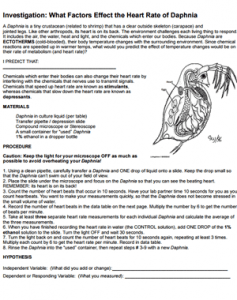
This investigation starts with a guided procedure where students gather data on the heart rate of daphnia when the organism is exposed to 1% ethanol. Daphnia are tiny crustaceans that are visible with the naked eye, though a microscope or stereoscope will be needed to see their heart rate.
Daphnia is a genus of small, planktonic crustaceans commonly referred to as water fleas due to their jerky swimming movements resembling those of fleas. They belong to the class Branchiopoda and are found in freshwater environments such as ponds, lakes, and rivers worldwide.
Daphnia are very interesting to observe because they are transparent, with the organs easily visible. These water fleas have a relatively simple body structure. They have a distinct head, thorax, and abdomen. Their bodies are enclosed in a translucent carapace, or “shell,” which protects their internal organs. Daphnia have two pairs of antennae, with the first pair being longer than the second. They also have several pairs of thoracic limbs used for swimming and feeding. These limbs create a jerky, hopping motion, giving them the appearance of tiny fleas.
Unfortunately, they are not the easiest to care for long term, recommended you buy a culture from biological supply companies. You can also order daphnia eggs from amazon, but those have mixed reviews. Daphnia are filter feeders, primarily consuming algae, bacteria, and other small organic particles suspended in the water. They use their modified limbs to create a current, bringing food particles into their mouthparts for ingestion.

Part 2: Student Designed Experiment
Students design and conduct an experiment that will test another variable. Instructors can provide other chemicals to test, such as sugar, or saccharin, or students can design a test for temperature. Part 2 is inquiry based (open-ended) and requires students to gather data, formulate conclusions and turn in a short lab report.
Grade Level: 9-12 | Time Required: 45-60 minutes
HS-LS1-3 Plan and conduct an investigation to provide evidence that feedback mechanisms maintain homeostasis.
NGSS – 8 Practices of Science – Planning and carrying out investigations

